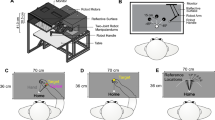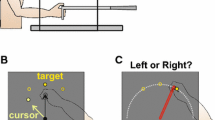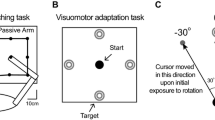Abstract
Previous studies have shown that both young and older subjects adapt their reaches in response to a visuomotor distortion. It has been suggested that one’s continued ability to adapt to a visuomotor distortion with advancing age is due to the preservation of implicit learning mechanisms, where implicit learning mechanisms include processes that realign sensory inputs (i.e. shift one’s felt hand position to match the visual representation). The present study examined this proposal by determining if changes in sense of felt hand position (i.e. proprioceptive recalibration) follow visuomotor adaptation in older subjects. As well, we examined the influence of age on proprioceptive recalibration by comparing young and older subjects’ estimates of the position at which they felt their hand was aligned with a visual reference marker before and after aiming with a misaligned cursor that was gradually rotated 30° clockwise of the actual hand location. On estimation trials, subjects moved their hand along a robot-generated constrained pathway. At the end of the movement, a reference marker appeared and subjects indicated if their hand was left or right of the marker. Results indicated that all subjects adapted their reaches at a similar rate and to the same extent across the reaching trials. More importantly, we found that both young and older subjects recalibrated proprioception, such that they felt their hand was aligned with a reference marker when it was approximately 6° more left (or counterclockwise) of the marker following reaches with a rotated cursor. The leftward shift in both young and older subjects’ estimates was in the same direction and a third of the extent of adapted movement. Given that the changes in the estimate of felt hand position were only a fraction of the changes observed in the reaching movements, it is unlikely that sensory recalibration was the only source driving changes in reaches. Thus, we propose that proprioceptive recalibration combines with adapted sensorimotor mappings to produce changes in reaching movements. From the results of the present study, it is clear that changes in both sensory and motor systems are possible in older adults and could contribute to the preserved visuomotor adaptation.






Similar content being viewed by others
References
Adamo DE, Martin BJ, Brown HS (2007) Age-related differences in upper limb proprioceptive acuity. Percept Mot Skills 104:1297–1309
Adamo DE, Alexander NB, Brown HS (2009) The influence of age and physical activity on upper limb proprioception ability. J Aging Phys Act 17:272–293
Anguera JA, Reuter-Lorenz PA, Willingham DT, Seidler RD (2010) Failure to engage spatial working memory contributes to age-related declines in visuomotor learning. J Cogn Neurosci. (in press)
Bock O (2005) Components of sensorimotor adaptation in young and elderly subjects. EBR 160:259–263
Bock O, Girgenrath M (2006) Relationship between sensorimotor adaptation and cognitive functions in younger and older subjects. EBR 169:400–406
Buch ER, Young S, Conrera-Vidal JL (2003) Visuomotor adaptation in normal aging. Learn Memory 10:55–63
Cressman EK, Henriques DYP (2009) Sensory recalibration of hand position following visuomotor adaptation. JNP 102:3505–3518
Cressman EK, Henriques DYP (2010) Reach adaptation and proprioceptive recalibration following exposure to misaligned sensory input. JNP 103:1888–1895
Ferrell WR, Crighton A, Sturrock RD (1992) Age-dependent changes in position sense in human proximal interphalangeal joints. Neuroreport 3:259–261
Fuentes C, Bastian A (2010) Where is your arm? Variations in proprioception across space and task. JNP 103:164–171
Goble DJ, Coxon JP, Wenderoth N, Van Impe A, Swinnen SP (2009) Proprioceptive sensibility in the elderly: degeneration, functional consequences and plastic-adaptive processes. Neurosci Biobehav Rev 33:271–278
Henriques DYP, Soechting JF (2003) Bias and sensitivity in haptic perception of geometry. Exp Brain Res 150:95–108
Heuer H, Hegele M (2008) Adaptation to visuomotor rotations in younger and older adults. Psychol Aging 23:190–202
Jones SH, Cressman EK, Henriques DYP (2010) Proprioceptive localization of the left and right hands. Exp Brain Res 204:373–383
Kaplan FS, Nixon JE, Reitz M, Rindfleish L, Tucker J (1985) Age-related changes in proprioception and sensation of joint position. Acta Orthop Scand 56:72–74
Kesten H (1958) Accelerated stochasitc approximation. Ann Math Stat 29:41–59
Krampe RT (2002) Aging, expertise and fine motor movement. Neurosci Biobehav Rev 26:769–776
McNay EC, Willingham DB (1998) Deficit in learning of a motor skill requiring strategy, but not of perceptuomotor recalibration, with aging. Learn Memory 4:411–420
Meeuwsen HJ, Sawicki TM, Stelmach GE (1993) Improved foot position sense as a result of repetitions in older adults. J Gerontol 48:137–141
Miall RC, Wolpert DM (1996) Forward models for physiological motor control. Neural Netw 9:1265–1279
Ostry D, Darainy M, Mattar A, Wong J, Gribble PL (2010) Somatosensory plasticity and motor learning. J Neurosci 30:5384–5393
Ota M, Obata T, Akine Y, Ito H, Ikehira H, Asada T, Suhara T (2006) Age-related degeneration of corpus callosum measured with diffusion tensor imaging. Neuroimage 31:1445–1452
Redding GM, Wallace B (1996) Adaptive spatial alignment and strategic perceptual-motor control. J Exp Psychol Hum Percept Perform 22:379–394
Redding GM, Rossetti Y, Wallace B (2005) Applications of prism adaptation: a tutorial in theory and method. Neurosci Biobehav Rev 29:431–444
Reuter-Lorenz P, Sylvester C-UC (2005) The cognitive neuroscience of working memory and aging. In: Cabeza R, Nyber L, Park D (eds) Cognitive neuroscience of aging: linking cognitive and cerebral aging. Oxford University Press, London, pp 186–217
Salat D, Tuch D, Greve D, van der Kouwe A, Hevelone N, Zaleta A, Rosen B, Fischl B, Corkin S, Rosas H, Dale A (2005) Age-related alterations in white matter microstructure measured by diffusion tensor imaging. Neurobiol Aging 26:1215–1227
Seidler RD (2004) Multiple motor learning experiences enhance motor adaptability. J Cog Neurosci 16:65–73
Seidler RD (2006) Differential effects of age on sequence learning and sensorimotor adaptation. Brain Res Bull 70:337–346
Seidler RD (2007) Older adults can learn to learn new motor skills. Behav Brain Res 183:118–122
Shaffer S, Harrison A (2007) Aging of the somatosensory system: a translational perspective. Phys Ther 87:193–207
Simani MC, McGuire LM, Sabes PN (2007) Visual-shift adaptation is composed of separable sensory and task-dependent effects. J Neurophysiol 98:2827–2841
Stelmach GE, Sirica A (1986) Aging and proprioception. Age 9:99–103
Treutwein B (1995) Adaptive psychophysical procedures. Vision Res 35:2503–2522
van Beers RJ, Wolpert DM, Haggard P (2002) When feeling is more important than seeing in sensorimotor adaptation. Curr Biol 12:834–837
Welford AT (1981) Signal, noise, performance, and age. Hum Factors 23(23):97–109
Wolpert DM (1997) Computational approaches to motor control. Trends Neurosci 1:209–216
Wolpert DM, Ghahramani Z, Jordan MI (1995) An internal model for sensorimotor integration. Science 269:1880–1882
Acknowledgments
We wish to thank Yulia Metersky for help with data collection. This work was supported by Canadian Institute of Health Research—Institute of Neurosciences, Mental Health and Addiction and the Banting Foundation (DYPH). DS is supported by an Ontario Graduate Scholarship. DYPH is an Alfred P. Sloan Fellow.
Author information
Authors and Affiliations
Corresponding author
Rights and permissions
About this article
Cite this article
Cressman, E.K., Salomonczyk, D. & Henriques, D.Y.P. Visuomotor adaptation and proprioceptive recalibration in older adults. Exp Brain Res 205, 533–544 (2010). https://doi.org/10.1007/s00221-010-2392-2
Received:
Accepted:
Published:
Issue Date:
DOI: https://doi.org/10.1007/s00221-010-2392-2




